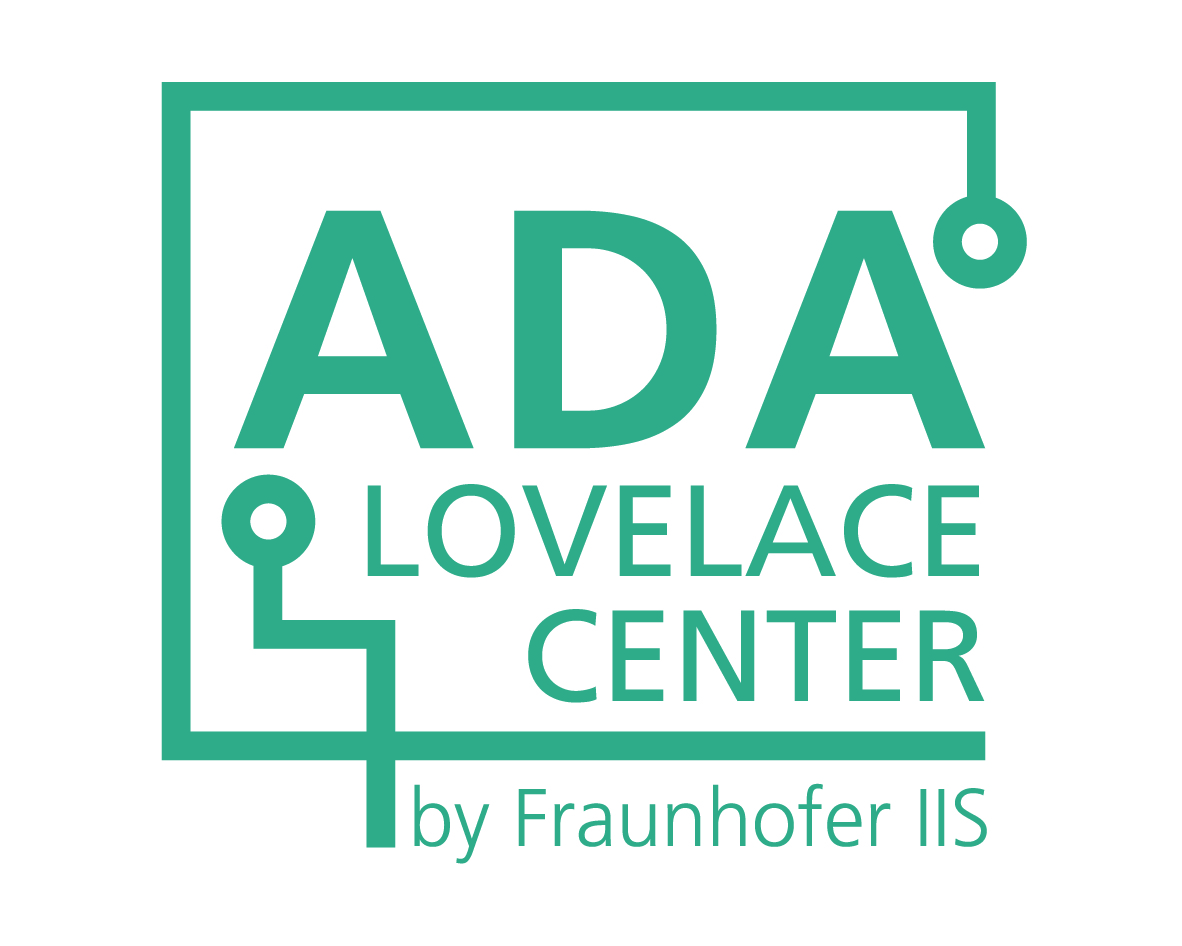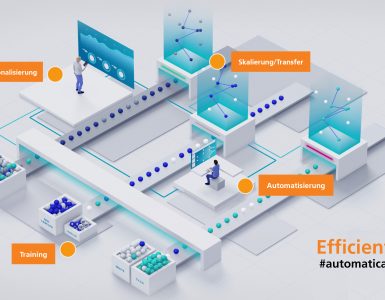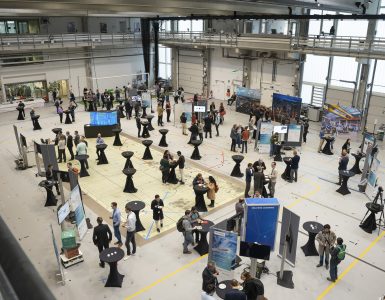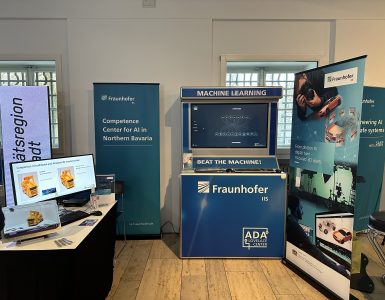Heute möchte ich Ihnen eine weitere Frau aus dem ADA Lovelace Center vorstellen.
Eine Frau, die hinter den Kulissen wirkt und dafür sorgt, dass alles, was für den Erfolg des Projekts notwendig ist, läuft. Dass die Timings und Formalien für die Fördergeber eingehalten werden. Dass Austausch stattfindet. Und dass die Wissenschaftlerinnen und Wissenschaftler sich ganz in ihre Inhalte vertiefen können. Für all das braucht es jemanden, der das große Ganze im Blick behält und als Ansprechpartnerin dient. Im Fall des ADA Lovelace Center ist das die Projektleiterin Nadine Chrobok-Pensky. Ich durfte ihr einige Fragen stellen zu ihrer Rolle als Projektleiterin, zum Projekt selbst und zu KI im Allgemeinen.
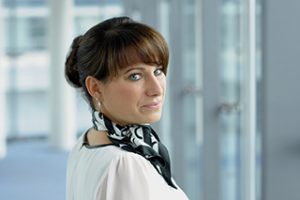
Wer bist du und was ist deine Aufgabe im ADA Lovelace Center for Analytics, Data and Applications?
Hallo Ada, mein Name ist Nadine. Ich bin seit 2011 am Fraunhofer IIS beschäftigt und habe 2019 die Projektleitung des ADA Lovelace Center for Analytics, Data and Applications übernommen. Meine Aufgabe ist es, sicherzustellen, dass die Projektziele, unter Einhaltung der Termin-, Kosten- und Qualitätsvorgaben erreicht werden. Dazu stellen wir den Projektmitarbeitern notwendige Tools, Vorlagen und Informationen zur Verfügung und organisieren eine Reihe von Meetings für den projektinternen Austausch.
Wow – das klingt vielschichtig. Was macht dir am meisten Spaß an deiner Aufgabe?
Beeindruckend finde ich die Vielfalt der Themen, denen wir uns im ADA Lovelace Center widmen. Die Forschungsfragen der Teilprojekte reichen von Themen aus dem Bereich Autonomes Fahren bis hin zu Logistik und Schienenverkehr. Wir beschäftigen uns aber auch mit Sport und Medizintechnik. So wird es inhaltlich nie langweilig und man hat Kontakt zu unglaublich vielen spannenden Expertinnen und Experten, die im Projekt mitarbeiten.
Apropos Experten: Was ist dir bei der Zusammenarbeit mit dem ADA-Team denn besonders wichtig?
Bei der Zusammenarbeit ist es mir wichtig, mich auf meine Kollegen verlassen zu können. Am meisten Freude macht es also, wenn Termine für die Zuarbeit eingehalten werden und Rückmeldungen zeitnah und fristgerecht erfolgen. Noch wichtiger ist mir aber die persönliche Beziehung und das Vertrauen der Kollegen zu genießen und die Person zu sein, die bei Problemen oder Fragen jederzeit angesprochen werden und auch helfen kann.
Was ist für dich das Besondere an diesem Forschungsprojekt?
Die Größe des Projekts und die inhaltliche Vielfalt sind bemerkenswert beim Ada Lovelace Center. Mit einem Gesamtbudget von 20 Millionen Euro und einer Laufzeit von fünf Jahren ist dieses Projekt auch am Fraunhofer IIS eine Besonderheit. Insgesamt arbeiten hier aktuell ca. 100 Kolleginnen und Kollegen zusammen und die Kommunikation läuft über ca. 20 Teilprojektleitende. Damit werden kleine Probleme manchmal ganz schnell zu großen Problemen, da man nicht so schnell die Teilprojektleiter anrufen kann oder beispielsweise 20 Einzelberichte zu einem einheitlichen Zwischenbericht zusammenführen muss. Durch die Projektgröße sind solche Aufgaben ziemlich komplex.
Worauf bist du in diesem Forschungsprojekt besonders stolz?
Auf die Ergebnisse, die wir bis heute schon erreicht haben. Wir haben es geschafft, aus den Kolleginnen und Kollegen des Fraunhofer IIS, der am Projekt beteiligten Fraunhofer-Institute IKS und IISB, sowie den Kolleginnen und Kollegen der FAU und LMU ein Projektteam zu formen, das Freude hat, sich über Institutsgrenzen hinweg fachlich auszutauschen. So entstehen neben Lösungen für die Herausforderungen im Projekt auch Ideen für neue gemeinsame Projekte und die weitere Zusammenarbeit. Durch die Zusammenarbeit in den Kompetenzsäulen kann das methodische Know-how durch die Verknüpfung mit den verschiedenen Anwendungsszenarien schneller erweitert werden und Wissen nachhaltiger aufgebaut und gesichert werden. Mit der Zusammenarbeit in der Matrixstruktur (Projektmitarbeiter arbeiten in einer Applikation, aber auch in den Kompetenzsäulen) konnten wir im Rahmen des ADA Lovelace Center eine neue Struktur der Forschungsarbeit umsetzen und testen. Zu sehen, wie gut diese Strukturen nach anfänglichen Schwierigkeiten nun mittlerweile funktionieren, freut mich sehr. Und ganz besonders stolz machen mich die Forschungsergebnisse, die meine Kolleginnen und Kollegen schon auf wissenschaftlichen Konferenzen präsentieren durften oder die im Rahmen von Folgeprojekten mit Industriepartnern nun in der Praxis umgesetzt werden.
Ihr habt in der bisherigen Laufzeit schon ganz schön viel erreicht. Wie sieht deine Vision aus für das Projekt und die Zeit danach?
Eine meiner aktuellen Hauptaufgaben ist die Planung, wie es nach Ablauf des Projektes mit dem ADA Lovelace Center weitergehen soll. Mein größter Wunsch ist es, dass sich die im Projekt entwickelten Kompetenzsäulen etablieren und methodisches Expertenwissen in viele weitere Projekte eingebracht werden kann. Außerdem möchten wir uns in der Endphase des Projekts mehr darauf fokussieren die Forschungsergebnisse und unser erworbenes Know-how in die Praxis zu bringen. Meine Vision ist, dass sich das ADA Lovelace Center als Marke für Spitzenforschung im Bereich Analytics sowie den Transfer von KI-Methoden in die Industrie noch besser etabliert und gerade für KMUs ein guter Projekt- und Ansprechpartner wird.
Was war eins der Highlights für dich an diesem Projekt?
Ein Highlight bisher war auch die Auftaktveranstaltung mit ca. 150 geladenen Gästen. Es war schön zu sehen, welch Interesse an unserer Forschung besteht und wie hier Wissenschaft und Wirtschaft in den Austausch kommen können. Dementsprechend freue ich mich auch schon auf das nächste große Event im März 2023: bei dem kommen internationale Forscher zusammen und können sich zu den Methoden und Kompetenzen im Bereich KI austauschen. Aber auch die Industrie wird davon profitieren, nicht nur in der weiteren Zusammenarbeit und Weiterentwicklung innerhalb des Projektes, sondern auch bei der anschließenden Konferenz. Der Transfer von KI Forschung in konkrete Anwendungen steht hierbei im Mittelpunkt und der Austausch kann auf dieser Ebene weitergeführt werden.
Man merkt, dass du auch inhaltlich sehr für das Thema KI und dein Projekt brennst. Was fasziniert dich so an dem Gebiet der Künstlichen Intelligenz?
Mich fasziniert, wie der Einsatz von Künstlicher Intelligenz unser Leben bereichern kann, was heute bereits alles möglich ist und wo KI schon überall drinsteckt. Und am besten ist es dann, wenn man die im Projekt entwickelte KI erlebt! Zum Beispiel, wenn man mit der U-Bahn durch Nürnberg fährt und weiß, dass die Abfahrtszeiten von einer im ADA Lovelace Center entwickelten KI optimiert werden, um Energie zu sparen.
Stell dir mal vor, in der Zukunft wäre alles möglich: was würdest du dir für den Fortschritt durch KI wünschen?
Ich würde mir ein intelligentes Haus wünschen, welches die Hausarbeit für mich erledigt, immer sauber und aufgeräumt ist und sich ums Essen kümmert. So hätten meine Familie und ich viel mehr Zeit für gemeinsame Unternehmungen und für unsere Hobbies.
Danke liebe Nadine für das Gespräch und die Einblicke, die du uns in deine Arbeit für das Projekt und auch persönlich gegeben hast.
Today in focus: The project manager of the ADA Lovelace Center
I would like to introduce you to another woman from the ADA Lovelace Center. A woman who works behind the scenes to make sure that everything necessary for the success of the project is running. That the timings and formalities for the funding providers are kept. That exchanges take place. And that the scientists can fully immerse themselves in their subject matter. For all of this, someone is needed who keeps an eye on the big picture and serves as a contact person. In the case of the ADA Lovelace Center, this is project manager Nadine Chrobok-Pensky. I got to ask her a few questions about her role as project manager, the project itself, and AI in general.
Who are you and what is your role at the ADA Lovelace Center for Analytics, Data and Applications?
Hello Ada, my name is Nadine. I have been working at Fraunhofer IIS since 2011 and took over the project management of the ADA Lovelace Center for Analytics, Data and Applications in 2019. My task is to ensure that the project goals are achieved, while sticking to the schedule, cost, and quality requirements. To do so, we provide necessary tools, templates and information to the project team members and organize a series of meetings for internal project exchange.
Wow – that sounds complex. What do you enjoy most about your job?
I find the range of topics we address at the ADA Lovelace Center impressive. The research questions of the subprojects reach from topics in the field of autonomous driving to logistics and rail transport. But we also deal with sports and medical technology. So in terms of content, it never gets boring and you have contact with an incredible number of exciting experts who work on the project.
Speaking of experts: What is particularly important to you when working with the ADA team?
It is important for me to be able to rely on my colleagues. So it’s most enjoyable when deadlines for input are met and feedback is provided promptly and on time. Even more important to me, however, is enjoying the personal relationship and trust of my colleagues and being the person who can be approached and also help at any time if problems or questions arise.
What is special about this research project for you?
The size of the project and the diversity of content are remarkable about the Ada Lovelace Center. With a total budget of 20 million euros and a duration of five years, this project is also special at Fraunhofer IIS. A total of about 100 colleagues are currently working together here, and communication is handled by about 20 subproject leaders. This means that small problems sometimes become big problems very quickly, since it is not possible to call the subproject leaders so quickly or, for example, to merge 20 individual reports into a uniform interim report. Due to the size of the project, such tasks are quite complex.
What are you particularly proud of in this research project?
Of the results we have already achieved to this day. We have managed to form a project team from colleagues at Fraunhofer IIS, the Fraunhofer institutes IKS and IISB involved in the project, and colleagues at FAU and LMU, who enjoy exchanging ideas across institute boundaries. Thus, in addition to solutions for the challenges in the project, ideas for new joint projects and further cooperation are generated. By working together in the competence pillars, methodological know-how can be expanded more quickly by linking it to the various application scenarios, and knowledge can be built up and secured more sustainably. With the collaboration in the matrix structure (project members work in one application, but also in the competence pillars) we were able to implement and test a new structure of research work within the ADA Lovelace Center. I am very pleased to see how well these structures are now working after initial difficulties. And I am particularly proud of the research results that my colleagues have already been able to present at scientific conferences or that are now being put into practice in follow-up projects with industrial partners.
You have already achieved quite a lot in the project duration so far. What is your vision for the project and beyond?
One of my main tasks at the moment is planning how to continue with the ADA Lovelace Center after the project ends. My greatest wish is that the competence pillars developed in the project become established and that methodological expert knowledge can be brought into many other projects. Furthermore, in the final phase of the project, we would like to focus more on bringing the research results and our acquired know-how into practice. My vision is that the ADA Lovelace Center becomes even better established as a brand for cutting-edge research in the field of analytics as well as the transfer of AI methods to industry and becomes a good project and contact partner, especially for SMEs.
What was one of the highlights for you about this project?
A highlight so far was also the kick-off event with about 150 invited guests. It was great to see the interest in our research and how science and business can come into contact with each other. Accordingly, I’m already looking forward to the next big event in March 2023, when international researchers will come together to exchange methods and expertise in the field of AI. But industry will also benefit, not only in further collaboration and development within the project, but also at the subsequent conference. The transfer of AI research into concrete applications is the focus here and the exchange can be continued at this level.
It’s clear that you are also very passionate about the topic of AI and your project. What fascinates you so much about the field of artificial intelligence?
I’m fascinated by how the use of artificial intelligence can enrich our lives, what’s already possible today and where AI is already everywhere. And the best thing is to experience the AI developed in the project! For example, when you take the subway through Nuremberg and know that the departure times are optimized by an AI developed at the ADA Lovelace Center to save energy.
Imagine if everything were possible in the future: what would you like to see in terms of progress through AI?
I would want a smart house that does the housework for me, is always clean and tidy, and takes care of food. That way, my family and I would have much more time for joint activities and for our hobbies.
Thank you dear Nadine for the interview and the insights you gave us into your work for the project and also personally.

